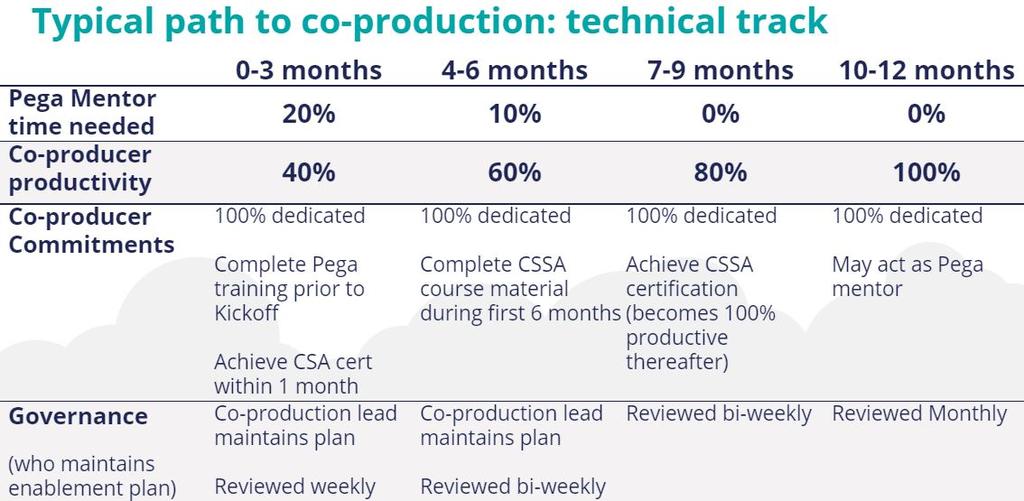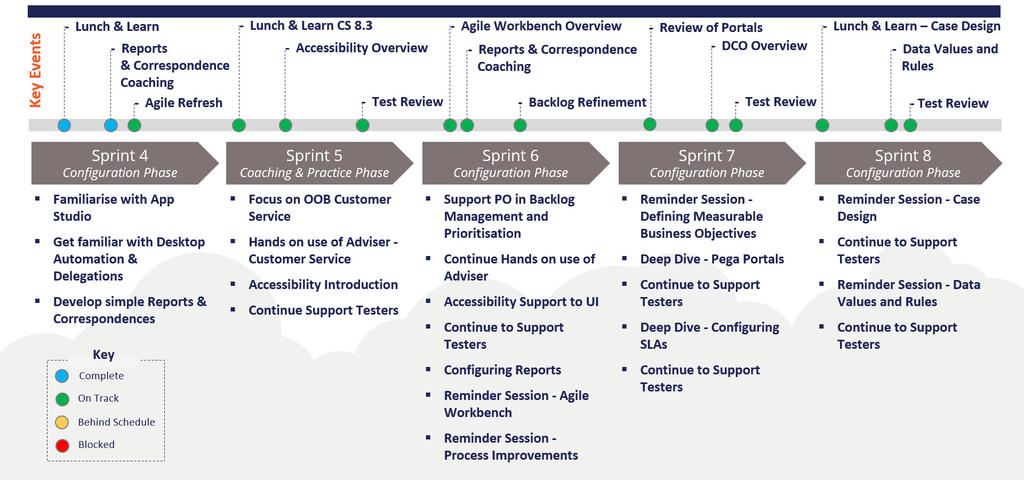
Resource planning
Identification of required project resources
Once you identify, prioritize, and size your Microjourneys™ as a Minimum Lovable Product (MLP), the next step is to determine what resources you need.
Based on your project complexity, consider:
- What roles are required to deliver successfully and when are they needed during the project
- The level of coaching and mentoring required to support co-production
- What experience levels are necessary on the project
- What Pega Platform™ product skills are required on the project (for example, Pega Customer Service™)
- Whether an onsite and virtual hybrid team is appropriate
- Whether a design sprint is required and what research and resources are needed to facilitate it
- What user interface (UI/UX) work is required
- Any local considerations, for example, work visa requirements for team members
Project Roles
Resources are available across leadership, business, and technical roles to support your Pega projects. The following table contains the different roles that are available.
| Role | Description |
|---|---|
| Project Lead | The Project Lead manages the project implementation; this person is responsible for governance and overall project success. |
| Business Architect (BA) | The BA captures business requirements and sets priorities ensuring business collaboration. |
| System Architect (SA) | The SA creates and modifies workflows, creates decision tables and decision trees, configures harness sections, and designs test cases. |
| Experience Designer (UI/UX) Designer | The experience designer brings expertise in the user interface (UI) and user experience (UX) to the project. |
For business and technical roles, there are a number of different levels based on experience and certification achieved. Using the System Architect role as an example, the role levels are as follows:
| SA Levels |
|---|
| System Architect |
| Senior System Architect |
| Lead System Architect |
Business project roles
The roles that are typically filled by the business team include the Product Owner, Scrum Master, and Test Lead/Testers.
Product Owner
- Represents the business and serves as a single point of contact for business decisions
- Participates in Directly Capture Objective (DCO) sessions
- Owns and manages the product backlog
- Sets stakeholder expectations
- Sets priorities for the scrum team's work
- Answers questions and clarifies details for the scrum team
- Accepts or rejects user story completion
Scrum Master
- Runs the daily stand up meeting
- Is dedicated full-time to the project team
- Teaches Scrum and coaches the team on Scrum best practices
- Facilitates meetings and events as required
- Removes impediments and barriers for the team
- Encourages collaboration between the Product Owner and the development team
- Encourages disciplined engineering practices and approaches to work
Test Lead/Tester
- Owns the end-to-end test plan for the business
- Organizes the test environments and deployments
- Manages test case creation and execution
- Tracks the resolution and retesting of defects
Coproduction
Coproduction is when your client identifies internal resources to become proficient in Pega products and Pega best practices. This process enables client team members to join and contribute to project delivery.
Coproduction resources learn how the application is being built and retain that knowledge for the client's organizations. Resources also bring their deep business understanding directly to the project team to influence the solution as it evolves. Coproducers become individually self-sufficient after the project has concluded, and once Pega certified, they can continue to develop their application and iterate to achieve additional business outcomes.
You can enable coproduction during the Discover phase to ensure that your MLP delivers the right outcomes successfully.
When considering coproduction:
- Determine the level of coproduction resources required to support the initial MLP
- Work with the client to identify people on in their company to fulfill those roles
- Ensure the resources start their certification training on Pega applications ahead of the project start
- Create a coproduction plan that maps the path from certification to hands-on involvement in the project work:
- You may need to supplement the plan with additional training and practice sessions to expose these people to the software in depth
- You can organize a series of lunch-and-learn sessions to cover specific topics with other Pega-certified experts
- Factor into your resource plan how productive the Coproduction resources will be - their proficiency and productivity will increase over time
- Consider how much mentoring and coaching time your project delivery team will spend with co-producers
- Assess other considerations (for example, whether the project will be run face-to-face in meetings or managed virtually)
The following image is an example of what a coproduction path might look like:
A twelve-month Co-Production enablement path looks like this:
Months 0-3
- Pega Mentor time needed: 20%
- Co-Producer productivity: 40%
- Co-Producer Commitments
- 100% dedicated
- Complete Pega training prior to project kick off
- Achieve CSA certification within one month
- Governance led by: Co-Production Lead maintains plan
- Governance reviewed: weekly
Months 4-6
- Pega Mentor time needed: 10%
- Co-Producer productivity: 60%
- Co-Producer Commitments
- 100% dedicated
- Complete CSSA course material in the first six months
- Governance led by: Co-Production Lead maintains plan
- Governance reviewed: bi-weekly
Months 7-9
- Pega Mentor time needed: 0%
- Co-Producer productivity: 80%
- Co-Producer Commitments
- 100% dedicated
- Achieve CSSA certification (becomes 100% productive thereafter)
- Governance led by: n/a
- Governance reviewed: bi-weekly
Months 10-12
- Pega Mentor time needed: 0%
- Co-Producer productivity: 100%
- Co-Producer Commitments
- May act as a mentor
- Governance led by: n/a
- Governance reviewed: monthly
The following image is an example of a coproduction enablement plan for Customer Service:
A Co-Production enablement plan should consist of a detailed plan that tracks:
- Throughout the project, purposefully scheduled regular sessions to develop knowledge and prepare for certification, led by team members and mentors. These may include lunch and learns or overviews in product or best practice capability.
- Aligned to each sprint should be activities and development activities that slowly builds the competency and contributors of the Co-Producers. For example, in an initial sprint this may be a tools overview, towards the later sprints deep diving how to configure SLAs.
Check your knowledge with the following interaction.
This Topic is available in the following Module:
If you are having problems with your training, please review the Pega Academy Support FAQs.
Want to help us improve this content?

